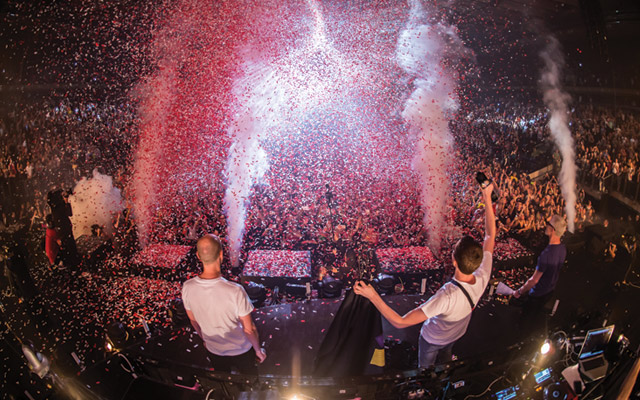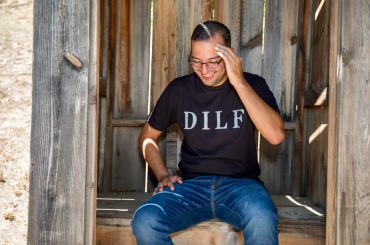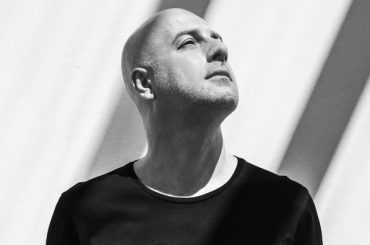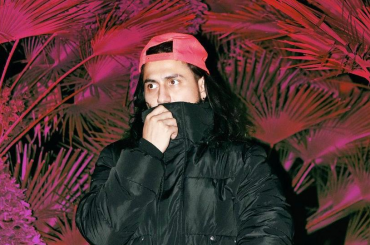No one doubts that Above & Beyond has spent the past decade and a half as one of the world’s biggest trance acts. After all, it’s not every group, electronic or otherwise, that can sell out a Madison Square Garden gig in a heartbeat, as the trio did this past October.
But ask the group’s Tony McGuinness to describe the music that he, Paavo Siljamäki and Jono Grant have been creating in recent years, and the “t” word doesn’t make the cut.
“I would say that it’s mostly electronic, mostly emotional, mostly dance music” his how he puts it, simply and succinctly.
He’s not wrong, he’s only telling part of the story: Give a listen to Above & Beyond’s latest full-length, We Are All We Need (Anjunabeats), and you’ll be treated to a bevy of styles, with trance playing only a supporting role. Released Stateside this past January on the Ultra label, the album is brimming with sunrise ambience (opener “Quieter is Louder”), stomping, industrial-tinged house (“Peace Of Mind”), soothing downtempo material (“Making Plans”), hands-in-the-air festival fodder (“Excuses”) and lots, lots more.
But Above & Beyond’s music, most of all, is pop—shimmering, spine-tingling electronic pop, the kind that uses arena-size EDM as more of a jumping-off point than as an end in itself. We Are All We Need, featuring vocal turns from Zoë Johnston, Justine Suissa, Alex Vargas, Gemma Hayes and McGuinness, is graced by dramatically emotive sounds that can sadden and elate in equal measure, made by an electronic act that makes the kind of heartfelt connection with its fans that few of its contemporaries can claim.
Of course, that connection is aided and abetted by the gang’s long-running radio show, Group Therapy (formerly Trance Around the World), and the music released on the Above & Beyond–affiliated labels, Anjunabeats and Anjunadeep.
In conversation, McGuinness comes off as an analytical sort of guy who’s truly curious about the world around him. Right after “hello,” he asks me about the provenance of my last name; I tell him that tale, too boring to relate here, and then he proceeds to tell me his.
“The name was originally McAngus in Irish, which means ‘son of Angus’—so I’m part of a Celtic dynasty. All the Anguses in Scotland are probably all part of the same family, too, if you go back 10,000 years. We’re all related somehow.”
And that leads the conversation towards druid ceremonies, which is where we pick up the conversation.
DJ Times: Ancient Celtic rites often involved a priest leading worshipers in communal dancing. That’s not so far off from what you do, really.
McGuinness: Indeed—we still do that now. Recently, I was talking to somebody about the validity of DJing versus being a musician, and I pointed out that the ancient lord of the dance was there before music existed, before people even knew about notes. He was the guy who would stand in front of the tribe, leading the log-banging and influencing the mood of the gathering.
DJ Times: And he would be the equivalent of today’s DJ?
McGuinness: Right. So, in some ways, DJing is an even more noble tradition than playing a musical instrument… not that there’s anything wrong with playing an instrument.
DJ Times: You’re still reveling in the afterglow of the release of We Are All We Need. But is putting an album together, rather than just releasing a series of singles, even necessary nowadays?
McGuinness: Yeah, it is. I used to read [music-industry commentator/curmudgeon] Bob Lefsetz’s entertaining e-mails, and one of the thing he says—which I think is mainly for effect—is that albums are dead. Obviously, the advent of iTunes, single-track downloads and streaming services mean that there’s a lot more access to single tracks, and consequently, they look like they are doing something that they’ve not done for a long while—dominating music sales.
DJ Times: I think there’s something like a 10-to-one ration when it comes to album downloads versus track downloads nowadays.
McGuinness: That may be the case. But I would counter that albums do work for us, and I think that all the successful artists in the world today—at least, those with any amount of longevity—do sell albums. There’s something about a collection of songs that says something that single songs can’t do. It allows to you to get your shit together before you open your mouth—and to say that this wide range of material, this wide range of subject matter, this wide range of tempos, of arrangements and instruments, is what we feel we represent. What an album represents is a much more complete and fulfilling thing to put into the marketplace than a single track. The nature of musical creativity is that it’s expressed in songs in the same way that literary creativity is expressed in words, but it gathers gravitas when you put them all together. And you want the thing to work in one solid listen, which they say nobody does anymore.
DJ Times: Are you’re convinced that they do?
McGuinness: There are supposedly so many things that nobody does anymore—but that’s just bollocks. For me, albums are the way I’ve always gotten into artists, and I still do. When you invest a little bit of time in it, getting to know the story and the journey and the way it moves from one bit to the other, it’s like a whole meal.
DJ Times: The Above & Beyond sound has obviously evolved over the past 14 years, but there is still a lineage from the earliest productions that runs through to the newer material. Is that something you’re conscious of?
McGuinness: Definitely. There’s a joy in using things that suggest other things that you’ve heard before. They can sound very pleasant. In some ways, those references become not so obvious as we progress, but they’re still in there, so there is definitely continuity with the past. And we’re even influenced by our own older material, so there’s that.
DJ Times: Other than that older work, what would you consider Above & Beyond’s influences to be?
McGuinness: When we started, we were trying to mix together the best bits of Ferry Corsten, in terms of the music; Paul Van Dyk, in terms of the banging-ness of the tracks; and Matt Darey, in terms of production finesse. They were the three shops that we bought most heavily from. That all went into the original style of Above & Beyond trance in the early part of this century, and within that, there have always been opportunities for us to put in bits and pieces from some of our favorite tracks and favorite artists. Within that sphere, I would put Chicane—and certainly Tiësto, who back then was doing loads of stuff that was very interesting. And then we would pull in stuff from outside of that world, from Depeche Mode and Prefab Spout to ambient soundtracks and film music. And lots more, too.
DJ Times: A lot of artists aren’t so upfront, or so specific, about their influences, as if they want us to believe that they’re creating their music in a vacuum.
McGuinness: Well, it’s very difficult to do something that sounds like nothing that people have ever heard before. Even the advent of a whole new genre, like drum-n-bass, had that recognizable thing—the drummer from James Brown music, played at twice the speed. It was fast, but it was recognizable. And that was considered a huge leap, nonetheless. So, yeah, everything is borrowed and assimilated and squeezed into our music.
DJ Times: Throughout the years, a lot of Above & Beyond’s music has blended an intimate, melancholy feel with one of grandeur. I think that a lot of producers strive for that combination, but few get there as successfully as you guys do. Is that something you have to work at, or does it come naturally?
McGuinness: I think that we definitely do try to make stuff to sound big, so that it will work in the environment in which we play live. But you’ve hit upon something interesting: The “intimate” bit was completely accidental. Above & Beyond started out by remixing, and then two things happened quite quickly. One was that we started writing songs together, and the songs that we wrote were songs about our lives—our girlfriends, our ex-girlfriends or whatever else it was. And those songs tended to be these sensitive, sad, melancholy things.
DJ Times: So that feel came organically?
McGuinness: Yeah, but I can remember having some heated discussions about whether that kind of song was appropriate for the quote–dancefloor–unquote… especially a song like “Alone Tonight,” which on the face of it is about isolation, specifically isolation when you’re in a relationship and you don’t communicate. We got a resounding reality check the first couple of times we played it—I think on the radio show, and then at Global Gathering in the U.K., in a tent full of 8,000 people—and when it got to the chorus, every single person in the room was singing along as loud as possible.
DJ Times: Wow.
McGuinness: Yeah, and it suddenly hit me that one of the reason people go out to nightclubs and gigs is because maybe they want to meet people; maybe they want to be with other people; maybe you’ve got your own issues, and when you get there, maybe you find out that there are 7,999 people who feel the same way that you do. Even if the personal headspace that you are bringing is one of sadness—which we’re all prone to, as humans—then the feeling that you’re not alone, literally, is really powerful. I had realization that lyrics that are very personal and confessional can also be very anthemic. That was a real eye-opener.
DJ Times: That was your first full-scale show, right?
McGuinness: That was our first big gig. And to see the physical joining of people in this big mass of lonely humanity, finding this energy and a kind of reassurance, was amazing.
DJ Times: I’ll bet!
McGuinness: It opened up a world of possibilities. You don’t need to just sing about dancing. You don’t need to sing about girls’ bums or who you’re fucking.
DJ Times: I don’t recall hearing very many songs about girl’s bums on We Are All We Need.
McGuinness: No, you don’t, though I’m not particularly denigrating those things.
DJ Times: Above & Beyond is known for having a rabid fan base, and I think the emotional connection that your music makes with people goes a long way towards explaining that.
McGuinness: I do, too, and I’m glad you said that. We’ve been doing a lot of interviews recently—with a lot of big press, with people who have never heard of us—and they want to attribute our success to some kind of marketing trick, some kind of community-building effort that’s got nothing to do with the music. But frankly, it’s all about the music. The reason we do as well as we do is because people connect with that music; they certainly don’t connect with us as pin-ups!
DJ Times: How do you guys work together in the studio? Is it a real collaborative process, or is it more a case of simply sending files back and forth to each other?
McGuinness: There’s no formula, really. But generally speaking, either Jono or Paavo will write a music track. Paavo tends to write on the piano, and Jono tends to write more in the computer. We’ll end up with this ever-increasing pile of songwriting beds—raw material for writing on. Some of them will end up being instrumentals, of course, but with the others, Zoë or Justine or I will write a song on top. Then, we’ll tend to take that song away from the original writing bed, and we’ll produce it for the dancefloor.
DJ Times: So far, so good…
McGuinness: There are many exceptions to that method. Sometimes Zoë or I will sit down together with Jono or Paavo, and have the song and the music happen at the same time. That was the case with “Making Plans,” for instance. As far as getting the arrangement right and getting the mix right, it’s usually fully collaborative. We’re all hovered around the computer—adding bits and taking bits away, trying different basslines and riffs, and just keep going ’til we’re all happy with it. It’s a method that’s worked pretty well.
DJ Times: Considering Above & Beyond’s success, that’s a bit of an understatement.
McGuinness: We actually got a bit unstuck with the new album, because it took so long to put together. A lot of the songs were written a while ago, and their tempo was too fast for where we’re now at [laughs], so they didn’t really work. We won’t make that mistake next time.
DJ Times: Switching gears, not many electronic acts go so fully into an acoustic phase as Above & Beyond did in 2013 and 2014 with the Acoustic album and a series of live gigs. What was the impetus behind doing that?
McGuinness: It was my idea, I’m afraid! When I was young and looking forward to being in a successful band, I thought about the two things that successful bands did. One of them was to be on Top of the Pops; the other was to be on MTV Unplugged. I loved the idea of taking songs that were familiar in one form and performing them in another, and it struck me that if we did that with Above & Beyond, it would be an even bigger leap than what a band like Nirvana did. The loudness, rhythm and intensity of our music would be in sharp contrast to doing something entirely acoustic. So, of course, I thought it would be a fun thing to do—to make the songs naked, as it were.
DJ Times: Above & Beyond’s rise has coincided, to a degree, with the rise of EDM. But unlike a lot of EDM acts, I get the feeling you are looking beyond EDM, and are in this for the long haul.
McGuinness: Definitely. Jono and Paavo were in university when we started this, and their dream was to do music full-time; that’s what they went to university for. And they want to keep doing that. I’ve been in a number of bands that have had a degree of success, but nothing like the success of Above & Beyond—and I’ve always wanted to do this full-time. So none of us are about to let this go, whatever the trends are. We all love writing and recording and performing. And most of all, connecting—that’s what makes it all worthwhile. When you scribble some thoughts down at 4 o’clock in the morning, turn that into a song, and then have 8,000 people singing them back to you… that’s the most fulfilling thing you can have. To be able to connect musically with people is enormously rewarding, and we’re lucky enough to be doing that. And we’re not about to give that up anytime soon.
Above & Beyond: Our Go-To Music Software
In our interview with Above & Beyond’s Tony McGuinness, we got into some tech-talk, and he detailed some of the group’s favorite software for DJing and music-making.
Apple Logic: “I hasten to add that it might not be our favorite, exactly, but this is the most important piece of software we use. It’s basically the one that we use to produce. It’s enormously powerful, robust, sounds great and never goes wrong. We’ve been using Logic since we started—that was Logic 5, if I recall correctly. We just upgraded to Logic Pro X, so we’re still finding our way around it.”
Ableton Live: “It’s what we use to construct our radio show and to practice DJing. We don’t actually use it for DJing, more just for seeing what records work together and things like that. Its genius invention is its variable time scale, which is very much the same as when you’re DJing on a deck with a variable-tempo control. But, for actual DJing, we still use Pioneer CDJs, and usually Pioneer mixers.”
Pioneer DJ rekordbox: “Speaking of Pioneer, I think rekordbox has improved enormously—though it’s still a little idiosyncratic, and clearly a piece of software written by a hardware company. Still, rekordbox 3.0 is a huge leap from where it was before. I really like the new cue-points system, where you can do things like fast-forward eight bars and put a cue point in—in case you missed the first one if you are clapping or drinking or smoking a fag. It’s like a get-out-of-jail card.”








